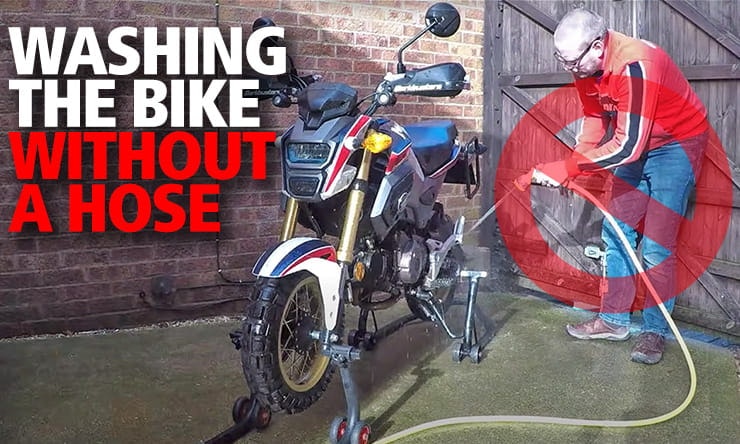How to clean your motorcycle without a hose
By John Milbank
Consumer Editor of Bennetts BikeSocial
16.08.2022
Whether you live in an area suffering from drought and with a hosepipe ban in place, or you simply don’t have access to a hose, here’s how to keep your motorcycle clean while using the minimum amount of water…
What bits of your bike MUST be clean
Some riders like cleaning their bikes more than others (it’s a great way to get to know your machine and to spot any problems), but your number plate must be clearly legible, or you could face an on-the-spot fine. The lights on your bike have to be kept clean too, so keep an eye on them all and use a damp cloth if necessary.
Getting rid of light dirt
If you’re struggling to wash your bike due to a hosepipe ban, then the chances are it’s not that dirty anyway, probably just suffering from bugs, bird-poo and dust. Here’s what we’d recommend…
For spot cleaning of bugs and bird-muck, thoroughly dampen a microfibre towel in water under the tap, then lay it on the affected area. The softened grime should wipe off easily after a while, though as with all vehicle cleaning, try to do it in a shaded area so the water doesn’t evaporate too quickly.
For dusty areas, the hose is great to avoid scratching, but if you can’t use one due to a hosepipe ban or lack of access, consider a pressurised sprayer like this one, or a larger one like this. According to Southern Water, a garden hose can use 1,000 litres per hour, so a 5 litre sprayer can be much more efficient.
Two buckets and a noodle wash mitt are the key to a clean, scratch-free bike
Cleaning a more dirty motorcycle with no hose
You’ll usually have plenty of warning of an imminent hosepipe ban, so if your bike’s still filthy after winter, give it a good clean before then. But if you simply don’t have access to a hose – maybe you live in a flat – you don’t have to spend money on garage jet-washes…
Use a degreaser like Muc-Off’s Motorcycle Degreaser on really grimy areas. As a general motorcycle cleaner, S100 Total Gel Cleaner is expensive, but the most effective. You’ll need a pressurised sprayer as mentioned above to rinse it off. A long-reach brush can really help to agitate the dirt and remove it – I recommend these. Choose the cleaner that’s best for you from my test of 69; you might be surprised about washing-up liquid.
If your bike’s chain driven, clean it with a dedicated chain cleaning spray or paraffin, ensure it’s dry, then use a decent quality lube. You can see my recommendations for the best chain lubes – out of 55 tested – here. A brush like this one from Oxford Products or this one from BikeIt can also be a big help.
For the bodywork, rinse any loose dirt and dust off with the pressurised sprayer, then do a ‘two bucket wash’. This is key to avoid scratching, and something you’ll hear from car detailers everywhere. Use one bucket with plain water to rinse your microfibre noodle mitt, and another with water and some car shampoo or washing up liquid in. Soak the clean mitt in the bucket with shampoo before gently wiping it over an area of the bike; the noodles help keep any grime away from the paintwork, unlike sponges which just drag the dirt across your paint. Be methodical to ensure you don’t miss anywhere, and just do a small patch before rinsing the mitt in the plain bucket, then dipping it into the shampoo one before working the next area.
Dry the bike off with a microfibre drying towel, spraying on some ‘speed wipe’ to avoid water marks as you go. This is the one I use. If you can get power to your bike, a dryer will really help prevent corrosion and blast moisture out of switchgear.
When the bodywork’s thoroughly clean, apply some wax to the paintwork. I really like this Collinite wax, though you might need a soft brush to dust out any residue that gets between gaps in panels.
For black plastic, S100’s colour refresher is excellent.
Finally, give the engine and suspension (NOT the brakes or tyres) a spray with a rust preventer. XCP Rust Blocker Clear Coat is my recommendation based on seven months of testing. If you get any on the paintwork, just wipe it away with a little speed wipe if necessary. It helps black plastics look better with a wipe over too.
Best motorcycle cleaner
Check out the full test of bike cleaners
What about waterless washes and wipes?
In a recent review of 69 motorcycle cleaners, I tested seven waterless washes and wipes. Some were surprisingly effective but keep in mind that they can be pricey, and they’re only intended for light dust.
The idea of a waterless wash is that it holds the dirt in suspension before being wiped away, but if you’re not careful, scratches could still be caused. They have their place though, as do cleaning wipes, which can be useful on wheel rims in particular.
The Pro-Green MX Pro Wipes performed well in testing and were safe on all surfaces. I’m also a big fan of Uniwipe Ultragrime wipes as they’re big, tough and last a long time. They’re not totally safe on polycarbonate, but they are great on wheels and hands!
Where to get the best deals on cleaning kit
Shop around as you’ll often find some good deals, but always make BikeSocial membership your first port of call, as you’ll find some great savings on cleaning kit and a lot more, including 10% off at Halfords.
